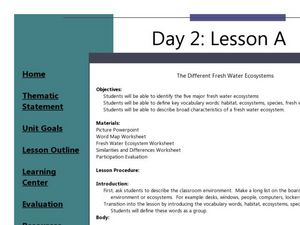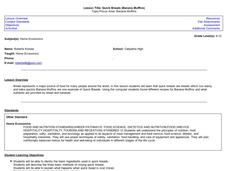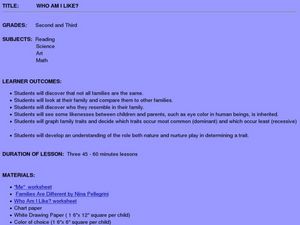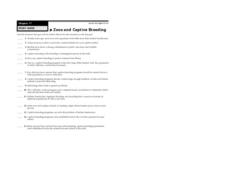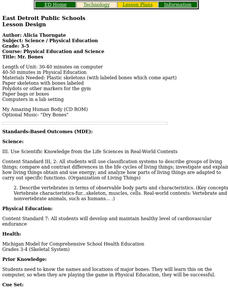Curated OER
Bermuda: Search for Deep Water Caves 2009: Out of Darkness
Students analyze the three models on the origin of troglobitic fauna. In this life science instructional activity, students also consider how the Zonation model explains the fauna's origin. They also use the Internet to research...
Curated OER
Plants Under Attack
Third graders will identify the four needs for plant survival and gain skills and confidence in using scientific measurement tools, probes as well as the spreadsheets and graphing capacity of a computer to represent and analyze data.They...
Curated OER
The Different Fresh Water Ecosystems
Students summarize the characteristics of an ecosystem. In this biology lesson, students identify five major fresh water ecosystem. They define terms and write a journal about what they learned.
Curated OER
Quick Breads (Banana Muffins)
Learners review what they know about quick breads and bananas. In this art activity, students discover two different recipes for Banana Muffins off of the computer. Learners prepare a recipe for Bananas Muffins carefully and clean up...
Curated OER
The Presidential Nominating System
Learners examine the process by which candidates for U.S. president are nominated by the Democratic and Republican parties. They identify the differences between primaries and caucuses and key terms and issues related to the primary...
Curated OER
Principles of Flight: Where are We?
Young scholars explore the concept of topographical maps. In this topographical map lesson, students discuss how airplanes know where to fly. Young scholars use topographical maps to simulate a field trip on the computer.
Curated OER
The Weather Around Us
First graders explore weather patterns. In this weather lesson, 1st graders research the daily weather by creating a graph of the daily weather conditions. Students use the computer to access information regarding the weather forecast....
Curated OER
Food Chains
Students study food chains by creating their own slide show using KidPix. They compare information after sharing their slide shows as a whole group. As the children are watching the slide shows of their peers, they tally every time...
Curated OER
Who Am I Like?
Students examine family structures. In this family structure lesson, students discover things about their own families and those of their classmates. They make a chart as they discuss nature versus nurture, complete a worksheet about who...
Curated OER
The Impact
Students study inventions and how they have impacted us. In this investigative lesson students study the history of two inventors then pretend that they are an inventor.
Kenan Fellows
Reading Airline Maintenance Graphs
Airline mechanics must be precise, or the consequences could be deadly. Their target ranges alter with changes in temperature and pressure. When preparing an airplane for flight, you must read a maintenance graph. The second lesson of...
Achievement Strategies
Unit/Chapter Design Template
A thorough lesson plan template allows teachers to design balanced and standards-based lessons for any grade. The template includes spaces for unit vocabulary and concepts, objectives, and additional resources.
Teach Engineering
Inside the DNA
Get your class to take a closer look at DNA. Pupils conduct research to determine the methods used by scientists to analyze the molecular structure of DNA. The class members investigate different types of molecular imaging along with gel...
Curated OER
A Stroll Down Memory Lane
Young scholars examine the functionality of different types of computer memory (RAM) as a springboard to researching the definitions, uses and functions of different common computer terms. The class creates a computer terminology guide.
Curated OER
Light and Shadows
Pupils explore shadows. In this shadow and light lesson, students predict what will happen to a shadow when the light source is dimmed. Pupils participate in a whiteboard interactive lesson.
Curated OER
Exploring Vaccines
High schoolers explain in a written format how vaccination works and how it draws upon the natural immunity. They differentiate between vaccinations and immunizations. Students identify a number of illnesses that can be prevented by the...
Curated OER
Visiting Museums
Students visit museums and gather information about dinosaur habitats, survival needs, and how they met these needs.
Curated OER
Micro-organisms
Students learn what a micro-organism is. In this micro-organism lesson, students understand that micro-organisms may be too small to see. Students learn microorganisms could be bacteria, fungi, something beneficial or a harmful microbe....
Curated OER
Food Chains
Students investigate how food chains work. In this food chains lesson plan, students construct a food web for a pear tree habitat. The interactive whiteboard is an optional tool in this lesson plan.
Curated OER
Zoos and Captive Breeding
After reading pages 470-472 of an unspecified textbook, middle schoolers compare statements about zoos and captive breeding to information presented in text for statements of truth. Students change statements that are false so that the...
Curated OER
Micro-controller Principles
Learners research micro-controllers and complete this 20 question instructional activity on micro-controller circuits using schematics. This instructional activity is printable and the answers are revealed online.
Curated OER
To Be or Not to Be - Abiotic/Biotic Factors
Middle schoolers define and compare/contrast abiotic and biotic factors presented while using web cameras on the Web World Wonders website.
Curated OER
Mr. Bones
Students play CD-ROM game My Amazing Human Body, and participate in relay game in Phys. Ed. where they put together skeleton on which body parts are labeled.
Curated OER
Protein Synthesis Activities
Students participate in a teacher-guided activity to teach about protein synthesis. Student roles include one person as the DNA molecule, another is a single stranded sequence of complementary mRNA.




